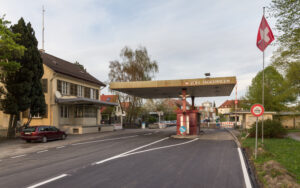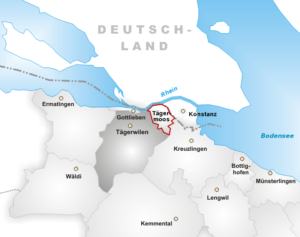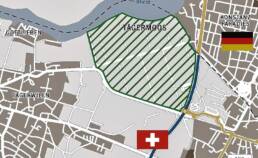Tägermoos, and an ancient treaty between Baden and Thurgau…
A unique agricultural border area of only 1.54 square kilometers is, at the same time, a district of a Swiss municipality and a district of a German city
“Das Tägermoos. Ein deutsches Stück Schweiz,” is the title of a book of historical reminiscences published in 2016 and signed by Tobias Engelsing. The expression.

“Musk of the wood” could mislead, insofar as it is a proper name, while the subtitle immediately gives the measure of a condition of exceptionality, “A piece of Germany ’embedded’ in Switzerland”.
There is in fact a singular place in the world that is, at the same time, a hamlet of a Swiss municipality and a district of a German city. A reality that, since the early Middle Ages, remains the “dual” affair, on an administrative level, of two municipalities that today belong to different nations: the Swiss Tägerwilen and the Germanic Constance.
Those boundaries between “high” and “low” justice
During the High Middle Ages, Tägermoos belonged to the “Thurgau possession” of the Diocese of Constance, the so-called “Bischofshöri”: Bishop Hermann I of Arbon (1138-1165) donated the land to the Scottish Abbey of St. James, founded in 1142 in Paradies.

In 1293, the town council of the German municipality purchased the Tägermoos from the abbey to use as common land. It was used primarily for cattle and draught animals from the 13th century until it was privatized in 1800.
In 1417 the free imperial city of Constance acquired the jurisdiction over the county of Thurgau as a pledge. In 1460 it lost its rights of “lower justice” over most of the territory when the “Old Swiss Confederation” conquered the area: Constance only retained jurisdiction over the balivates of Eggen, Raitigericht and Altnau.

During the Swabian War of 1499, “high justice” in Thurgau was lost to the court in Frauenfeld. In the course of the 14th century, the city of Constance succeeded in incorporating the nearby village of Paradies (then known as Eggenhusen), but failed to recapture the Tägermoos area.

With the collapse of the “Old Confederation” and the founding of the Helvetic Republic in 1798, a Swiss nation state coinciding with the old perimeter of “high justice” came into being.
The existing rights of “lower justice” were thus redistributed, especially since it was the former that determined the precise boundaries of the “fresh” country.
The latter right in the Tägermoos had in fact been held by the Confederation since 1499: that specific area and the adjoining areas of “high justice” in what is now Canton Thurgau were thus assigned to the new Helvetic Republic, while preserving the customary ownership and usage rights of the Teutonic municipality.
A treaty between Baden and Thurgau dated 1831

The special status of Tägermoos was defined once and for all in 1829 and fixed on March 28, 1831 in a treaty, still in force today and terminable only by mutual agreement, between the Canton of Thurgau and the Grand Duchy of Baden, which were succeeded by the Swiss Confederation and the Land of Baden-Württemberg.
The management of this 1.54 square kilometer area, drained and used for agricultural purposes, once a marshy common ground of the two communities who lived closely together, is currently divided into 18 plots of land with complicated and changing contractual relationships involving Constance and Thurgau.
The territory of Tägermoos lies on the southern bank of the Seerhein, a river just four kilometers long from the Bodensee, and there are just six inhabited properties with a total of about twenty residents: Ziegelhof, Zollhof, Trompeterschlössle, Weiherstrasse, Unter-Hochstrass and Ribi-Brunnegg.






